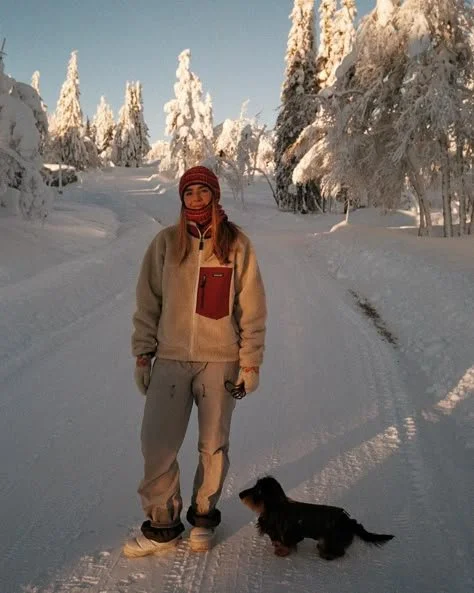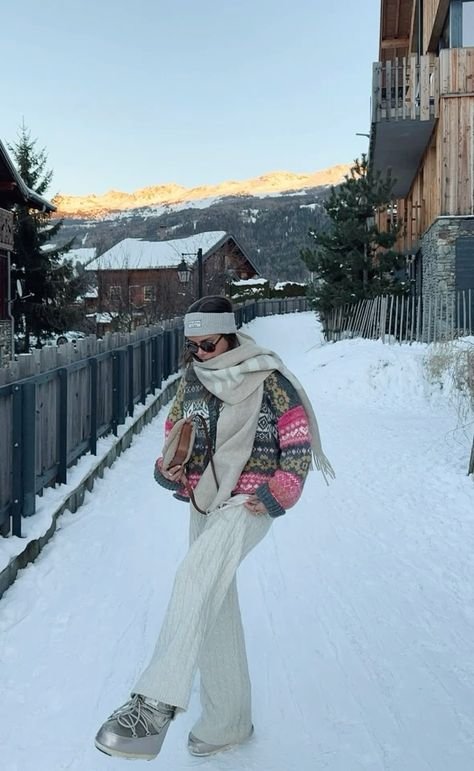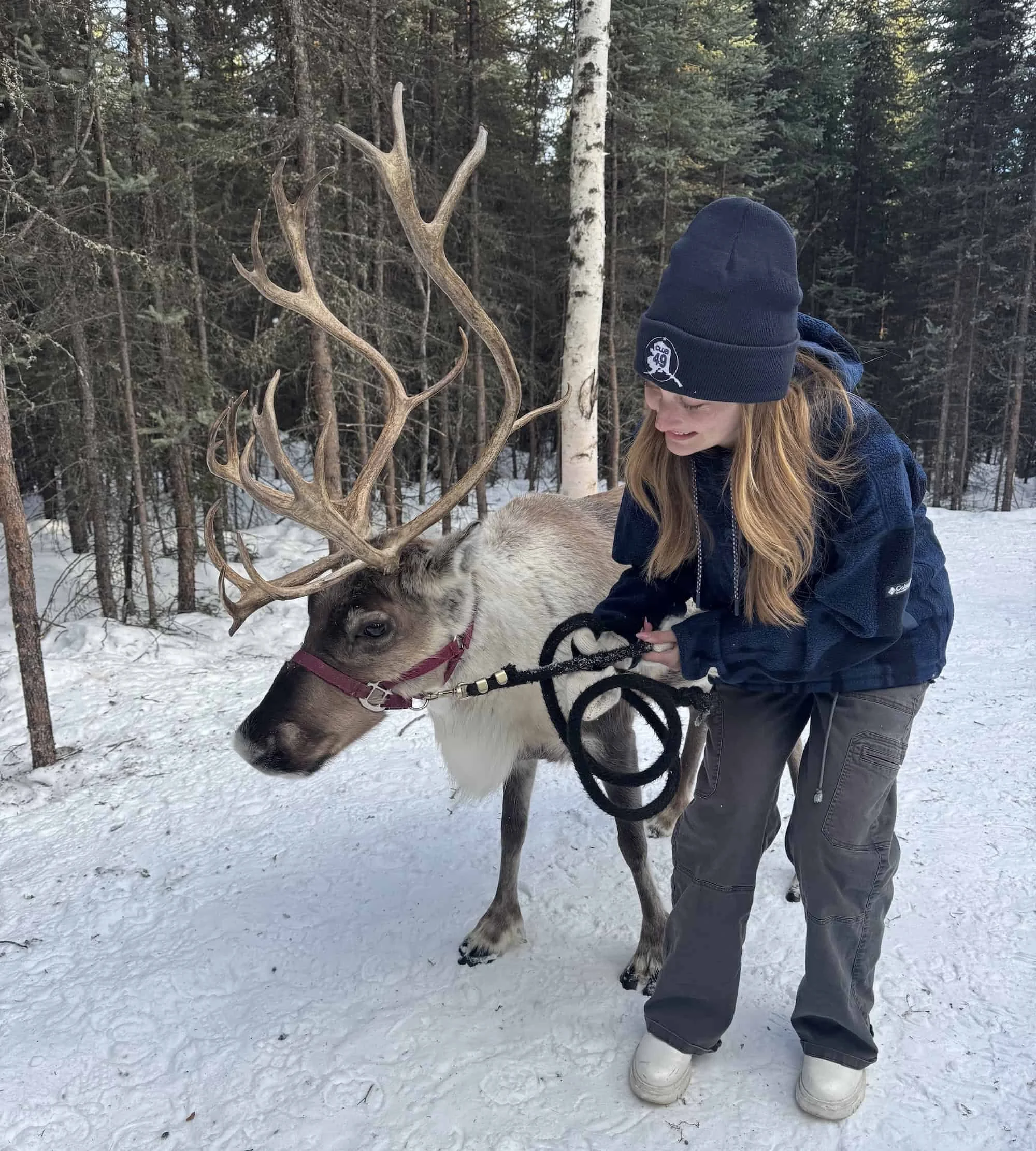What to Wear in Alaska in Winter: Layering in Extreme Cold
LAST UPDATED: SEPTEMBER 24, 2025 | EST. READING TIME: 8 MIN
IN THIS GUIDE ✺
Long Fur Coat
Oversized Puffer
Mid & Base Layers
Boyfriend Bottoms
Waterproof Boots
Fuzzy Ear Coverings
Packing for a winter trip to Alaska is no trivial feat; the extreme chill requires a thoughtful approach suited for the northern climate. The key to staying comfortable in winter appropriate ensembles are thoughtful layers functionally fitted for early mornings spent chasing the dancing aurora borealis.
Depending on how deeply into the snowy season you visit, increasing levels of insulation are required from your innermost garments to outer overcoats. The northernmost American state, brushing up against the Arctic environment means the norm is to prioritize function over fashion—although I say why not both! Fleece-lined long johns are the first layer to start with, ensuring your warm yet wicking attire traps air appropriately and won’t produce a chill when wet from snow or sweat.
A baggy mid layer is the next step in conserving your body heat, with slouchy boyfriend bottoms the ideal silhouette to pair on top of that—yes, winter in Alaska calls for three different coverings on both your top and bottom. Depending on your agenda, pick between a long fur coat or oversized puffer, the latter be suited for outdoor adventures where contact with snow is expected. Avoid cold toes with waterproof boots that will whisk precipitation away and fuzzy ear coverings for a fashionably practical accessory!
Keeping these what to wear in Alaska in winter guidelines in mind, incorporate the following elements when packing for snowy sightseeing around the last frontier:
Winter Climate in Alaska
Winter in Alaska brings stark, snowbound conditions as a subarctic chill settles over the last frontier. While bright, blue-sky days are possible, they’re often followed by long stretches of cloud cover, heavy snow and icy winds; pack insulated outerwear and protective cold-weather gear for the deep freeze. The dry air and low winter sun often casts a dusky glow across the snowscape, lending a crisp clarity to the wilderness.
Daytime temperatures in the coldest months of December and January often range from 0–20 °F (–18 to –6 °C), plunging well below zero degrees at night. Layering is essential: thermal base and mid layers, insulated parkas, lined boots with wool socks, and face protection against frostbite are non-negotiable in the dead of winter. By contrast, the spring shoulder season in March is more forgiving. With daytime highs climbing toward the mid-20s to low 30s °F (–4 to 0 °C), the cold isn’t as biting, and the lengthening daylight softens the edge of the season. Heavier gear is still needed, but you’ll often get away with lighter gloves and fewer layers during active outings, especially as the air begins to lose its cutting severity.
Snow remains abundant in March, making it an excellent month for skiing, aurora chasing, and outdoor treks without the deep-freeze fatigue of mid-winter. Expect 11–12 hours of daylight by late March—double what you’d find in December’s near-perpetual twilight—granting more time to explore during clear, dazzling days before temperatures dip again at night.
Even when facing frigid temps, it's worth braving the cold for bucket list experiences that only Alaska can offer—from flying over Mt. Denali to driving your own dog sled and chasing the northern lights.
What to Wear in Alaska?
Long Fur Coat
Bring a splash of elegance to the frontier in a luxurious long fur coat that feels like being bundled in a warm robe. An oversized overcoat is key, since progressively larger layering is the most important thing that you can do to stay warm when considering how to dress in Alaska’s winter.
Make sure your outermost option isn’t too tight once all your underlying layers are on—a small-sized base should go under a medium sweater, with that under a large coat. Tight-fitting layers restrict your blood flow and ability to move, meaning you'll be cold no matter how many you wear. When strolling around town, a long fur coat is a fashion-forward choice that can keep you bundled with a comfy robe silhouette.
Oversized Puffer
A waterproof, windproof oversized puffer is the perfect piece of functional fashion to wear over your other insulating layers. Ideal for active outdoor excursions like dog sledding, opt for a larger size compared to your base and mid pieces to ensure the jacket fits comfortably over your successive layers underneath.
Thumb holes cut into an inner wrist guard are a preferred enhancement to keep your palms warm when the gloves come off. Zippers can also be easier to fasten when working with gloved fingers compared to a row of buttons. A sturdy hood is another feature to prioritize, even better if a drawstring allows you to secure the opening tightly around your face.
Mid & Base Layers
Fleece-lined mid and base layers are a non-negotiable when it comes to staying warm in the Alaskan winter chill. Base layers including a long sleeve top and legging bottoms are the first layers that sit next to your skin, so they need to be warm and wicking. Avoid cotton which loses its ability to keep you warm when wet from snow or sweat; Merino wool is best but expensive, so synthetic fleece polyester blends made for wicking will do.
An insulating mid layer retains the heat your body generates by trapping air. Air between layers is crucial, as tight layers compress insulation and reduce its effectiveness. Ensure your mid layer fits over your base, possibly a size or two larger than you'd normally order.
Boyfriend Bottoms
Baggy denim and cargo boyfriend bottoms are loose enough to pull over insulating layers while still looking stylish. Warm legs lead to warm feet, so even though it can feel a bit bulky, avoiding cold toes is worth the added fabric around your bottom half—plus you’ll be covering up less flattering long johns.
Inherently oversized cuts like barrel and wide leg styles are ideal since your base layers need to fit comfortably underneath without restricting movement. Extra pockets on cargo pairs are an added perk, serving as storage for all your accessories when sitting down inside with a cup of hot cocoa. Seek out drawstring waists that can be worn loosely rather than tight button clasps.
Waterproof Boots
Prepare for winter outdoor activities with waterproof boots that won’t get damaged when snow melts on them, there should be no suede in sight.
Even more important than your shoes is what goes inside them—wool hiking socks ensure your feet stay dry. One to two pairs are ideal depending on the temperature; if it's colder than 15°F go for two if your socks layer well, otherwise one thick pair is better than squeezing a second on top of the first. Avoid restricting your blood flow with two pairs of the same size since hiking socks aren’t meant to be layered. In truly extreme cold scenarios, moisture-wicking bama sokkets will absorb excess moisture and keep your feet incredibly warm.
Fuzzy Ear Coverings
Keep your head warm with fuzzy ear coverings—whether you prefer mitts, fur headbands, or Alaskan trapper hats. A posh pom pom beanie isn't the most practical when it comes time to wear a ski helmet or hood, so for outdoor excursions a fleece-lined lambswool cap works best for layering.
Avoid ear muffs or headbands that don't cover the top of your hair when spending an extended amount of time outside, the majority of heat is lost from your head. For truly extreme temperatures, a neck gaiter and thick blanket scarf top off the optimal winter weather outfit formula to protect your face from the biting cold and snow gusts.
Alaska Winter Outfit Ideas
As an Amazon Associate I earn from qualifying purchases.
Spending 3 days in Fairbanks, Alaska during a mid-March trip up north, I styled three Arctic outfits suitable for extended days outside in the cold—with the caveat that it was the spring shoulder season, so I wasn’t facing truly below-zero temps.
Spending all night driving around through the Alaskan wilderness, my first outfit needed to be comfortable enough to snooze during the commute while insulated enough to keep me warm once the aurora borealis came out:
Oversized Quilted Ski Jacket from Bo and Tee, this season's style from Oh Polly ($195)
Last season's Bo and Tee oversized puffer checked the boxes of being insulating, windproof, and water-resistant, but their new rendition seems even more functional with detachable sleeves to double as a vest. The belt shapes a flattering figure with waistline definition and I'm always pro thumb holes to keep your palms warm when the gloves come off.
Fleece Half-Snap from Madhappy for Columbia Sportswear, Dupe from Columbia ($39.99, paid link)
While this limited edition half-snap was born from a brand collaboration, expect the same functional construction from Columbia’s standalone offerings. Size up so this mid layer fleece wears loosely over your base long johns.
Dreamsoft Travel Scarf from zestt ($50, paid link)
A slightly thinner option than my typical Acne Studios knock-off ($14.99, paid link), this travel scarf that also works as a blanket on the plane found its way into my Alaska carry-on for instances where I was seeking a more compact option to wrap around any exposed skin.
Maroon Headband from Fur Factory, Dupe from Amazon ($50, paid link)
A local find, come prepared with a similar fuzzy ear covering to add a cozy pop of color to your winter ensemble.
Winter Gloves from TRENDOUX ($17.08, paid link)
Waterproof hand coverings are essential for frolicking in the snow; when skiing I find gloves much better at handling poles. The touchscreen fingertips make this pair particularly neat in that you can use your phone while wearing them, and the windproof cuff ensures no skin is exposed between your wrist and jacket sleeve.
Soaring over the summit of Mt. Denali the next day, I was able to prioritize fashion over function given I’d be sitting inside an aircraft rather than exposed to the blustering elements:
Fur-Lined Suede Jacket from Scout, Dupe from Amazon ($36.99, paid link)
One of my best vintage finds to date, the fur lining inside this long suede exterior is as insulating as can be. When worn on a chilly day, it feels just like being bundled at home in a warm robe.
Thermajane Long Johns from Amazon ($29.99, paid link)
Not pictured but certainly appreciated, I brought two pairs of thermal underwear to Fairbanks in white and grey base layer sets. Including a long sleeve top and legging bottoms, these are the first layers that contact your skin, so they need to be warm and wicking. Merino wool is best but prohibitively expensive, so synthetic fleece polyester blends will do and worked perfectly for me!
Cream Long Sleeve Mock Neck from Princess Polly, Dupe from Amazon ($25.99, paid link)
A basic ribbed turtleneck staple, this isn’t exactly the most appropriate mid layer in that the top is cropped, but while visiting during the spring shoulder season I was graced with relatively warm temperatures. In the peak of winter, a full-length sweater would most certainly be required.
Furry Light Grey Adjustable Earmuffs from C.C. ($16.99, paid link)
A similar note as above, I wouldn’t have been able to get away with an exposed head if I had visited in December or January. Fortunately, I could opt for a cuter accessory which blocked out noise from the whirring engine.
My final day in Fairbanks sipping cocoa alongside the local wildlife led me to style a fashionably functional outfit that believe it or not entailed three layers on both my top and bottom halves:
Polar Fleece Thermal Joggers from baleaf ($36.99, paid link)
An insulating mid layer retains the body heat by trapping air—air between layers is crucial; tight layers compress insulation and reduce its effectiveness. Ensure your mid layer fits over your base, with these pants a size or two larger than what you'd normally order.
Running Pullover Sweatshirt from Soneven ($43.99, paid link)
The built-in neck gaiter and hood are extremely helpful for keeping your face warm, plus the thumbholes ensure the arms stay pulled down inside sleeves when putting a large outer layer on top.
Lightweight Fleece Hoodie from Madhappy for Columbia Sportswear, Dupe from Amazon ($32.99, paid link)
Another limited edition fleece, this was an appropriate outer layer for the sunny spring day.
Navy Cargo Pants from Tenshoppe LA, Dupe from Amazon ($32.99, paid link)
Tenshoppe doesn’t have an online store, but you can find a similar pair of loose boyfriend bottoms for your outermost layer above.
Dream Pairs Chelsea Platform Combat Boots from Amazon ($45.99, paid link)
Waterproof boots that whisk off any melting snow, but what’s inside them is almost more important. These Jeasona winter thermal hiking socks ($8.49, paid link)are made of wool which ensure your feet stay dry, unlike cotton which loses its ability to keep you warm when wet.
49th State Beanie from Alaska Airlines, Dupe from Amazon ($45, paid link)
Lucky enough to stumble upon an Alaska Airlines activation at the World Ice Art Championship, I copped this beanie for free. If I hadn’t, the fleece-lined lambswool option from Turtle Fur would’ve been my next best bet.
✺ ABOUT ME ✺
Hi, I’m Ashley. I’m determined to see the world. All of it. Are you coming with?
While I respect the digital nomads, van life, and the hardcore backpackers—that’s just not me.
I’m convinced I can travel and keep my job.
It’ll take a lifetime, but I’m going to make it to all 195 countries before my time is up—and I’m taking you along for the ride!
✺ READ MORE ON THE BLOG ✺





















































![How to Drive Moonview Highway IRL: Mario Kart Japan [2025]](https://images.squarespace-cdn.com/content/v1/652732149424c20baf5e26c9/1738472940390-H4PXMWODU3MAQVIIOJ8I/IMG_1412+copy+%281%29.jpg)


![Tokyo’s Top Sites – How to Buy Shibuya Sky Tickets [2025]](https://images.squarespace-cdn.com/content/v1/652732149424c20baf5e26c9/1736655941250-HONDE4J7JOOEN5NJNNLJ/IMG_8461+copy+%281%29.JPG)